By Jim Campbell, ANN CEO/Editor-n-Chief/Test Pilot (Arrogant, Over-Opinionated Know-It-All/Test Dummy)
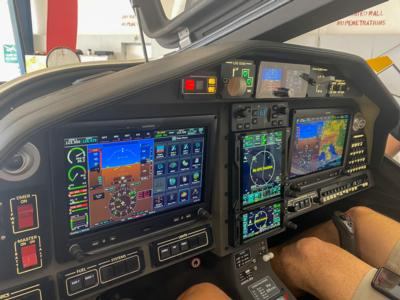
ANN E-I-C Note: Yeah… I ‘ve been slower than molasses on a winter’s day getting these out to you… but due to recent MAJOR upgrades and announcements (like the MASSIVE Roku and FireTV programs), there’s been precious little time to get all things done, that NEED to be done. However, here is Part 4... while Part Five (also complete) will follow in a few days and... Part Six should conclude this whole MASSIVE saga in a few weeks… I hope.
Once we were all ensconced in the Pipistrel Panthera, we proceeded with an altogether conventional fuel injected engine start, and completed a checklist dictated to me by Andy Chen, courtesy of ForeFflight. Apparently; this particular EFIS set up was not equipped with an MFD accessible checklist, which was not a problem since Andy is a big believer in using a checklist on an external device. He likes doing it this way so he's not running the battery down while the glass panels are powered up -- before the engine is producing power. He mentioned that the Garmin panels in the Panthera ate up batteries fairly quickly, so this seemed like a prudent alternative.
The derated Lycoming ran quite smoothly in this installation, and settled into a pretty decent idle right from the start… We didn't require a whole lot of extra throttle to get everything rolling and initial braking was powerful, obedient, and not too touchy. The initial impression of the rudder pedal response is that they take a bit of a push to get off dead center, but then you let off pressure almost immediately, because a little jab on the rudder pedal goes a long way. It's not oversensitive, per se, it's just something to understand in the way this particular mechanical control system operates. The end result, with a little practice, is an agile nose wheel that produces fairly responsive turns.
Let’s set out the conditions under which we flew this aircraft – something that far too few so-called flight tests due so as to properly qualify what effect external conditions might have on overall performance.
Florida’s Inverness Airport is 65’ MSL, and on the day we flew, we noted Surface OATs of 96-98 degrees (and climbing) -- hot – and humid, and more than 3000+ feet of density altitude that increased steadily throughout the day. We had about 400 pounds of pilots and personal gear, and another 180 pounds of fuel. The rear seats were unoccupied. CG was well within proper limits but a little on the forward side due to the lack of people or payload in the rear. Inverness offers a 5001-foot runway (01/19), so we had plenty of room to work with… though much of it would turn out to be FAR more than we needed.
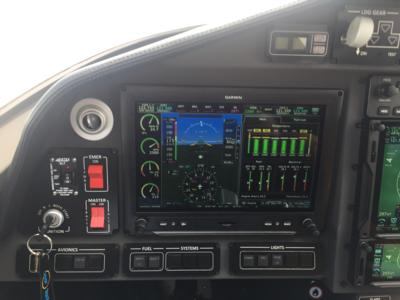
Mag check and other preflight activities completed, we lined up at the end of Inverness airport’s Runway one-nine, and smoothly applied power. Andy had originally dictated a takeoff procedure that I decided to substitute for one of my own that would allow me to gauge where and how much the tail surfaces started to do their job.
Not that anything he said was wrong, but I wanted to start feeling where the elevator and rudder started getting effective. So, I started the takeoff roll with pitch held full aft, and the minute I felt any kind of aerodynamic feedback, I lessened pitch in order to keep the nose light and slightly pitch positive, but not overly so. Rudder revealed itself to be effective very early in the ground roll… though I was a bit more miserly in its application than I should have been.
Something that becomes really evident early in the takeoff sequence, is that if you want to remain on or near the runway centerline, you better be prepared to feed in a lot of right rudder. I now completely understand why Andy Chen named his company Right Rudder Aviation…
Once yaw is not encumbered by the mechanical issues of the nose wheel’s contact/friction with the ground, yaw control feel lightens up significantly to produce a fairly linear response with light to moderate pressure. However, in the takeoff phase you need a lot of right rudder… A lot of right rudder. Did I mention that you need lots of right rudder? I had been told to lighten the nose at 70 to 75 knots but the initial acceleration of the slightly derated Lycoming blew through that as I was still digesting what the aircraft was telling me.
Still, in well under a thousand feet, maybe 800 or so, we were off the ground and assuming a deck angle that sure seemed to be imitating an ICBM. And worse than that, I wasn’t even pitching it properly at that point. 100 knots was suggested for initial climb, and I blew through that with 120 or so, simply because the deck angle initially looked so aggressive, and I started discovering the one downer about the Panthera -- that it’s blind as a bat directly over the nose, while firmly in a climb.
This is of course one of those things you deal with in a number of aircraft designs, and I’ve flown far worse (the visibility over the nose of the Sukhoi SU-29 comes to mind… Which is kinda like driving a Greyhound bus from the backseats). But that lovely long nose on the Panthera does inhibit climb visibility right over the center of the nose. So… The obvious solution is to lower the nose every now and then, or clear your airspace with light turns, so that you make sure you’re not about to ruin somebody else’s day, not to mention yours.
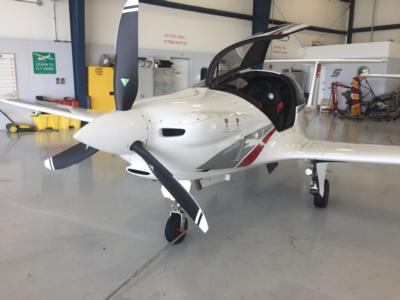
One good note is that the initial control feel made me comfortable from the start. Reasonably decent harmonies between yaw, roll, and pitch existed with yaw picking up the requisite wing with a moderate tap on the rudder, and pitch providing a smooth but fairly speedy response with a mostly linear response curve.
With 100 knots or so, the Panthera will easily do 1000 ft./m, even when you recall that we took off with nearly 100° ambient air temperature. On a cold day, you might need NASA’s permission to do a max performance climb…
But that brings up a different problem, albeit a temporary one. The current baffling and internal engine compartment design needs some tweaking. This is not that big a deal, and one assumes that the folks in Slovenia don’t get many 100° days, but by 3000 feet it became necessary to transition from a best rate of climb attitude, to a cruise-climb configuration at about 120 knots or so, because CHT’s were coming up fairly quick and starting to inhabit the initial caution area. Mind you, the minute you lower the nose and let the Panthera scoot a bit, temperatures ameliorate fairly obediently. But some work remains to be done on the internal baffling and configuration of the engine compartment in order to ensure more comfortable heat dissipation rates. I know that Andy is working on this in order to keep those who aren’t watching their CHT’s from cooking the engine. Again, this is fixable and should be underway by the time you read this. Regrettably; there are no cowl flaps on
the Panthera.
At an initial altitude of 3500 feet, and power adjusted to 2500 RPM and about 24 inches of manifold pressure, I let the Panthera accelerate to about 150 knots indicated while maintaining a light climb to avoid some cumulus crappy-stuff that settled in between 3500-6500 feet. With the nose in a more cruise-like configuration, the visibility situation did improve, but every now and then you’re still gonna want to lower the nose and see what’s ahead until you’re in a straight and level, balls to the wall, so-to-speak, configuration.
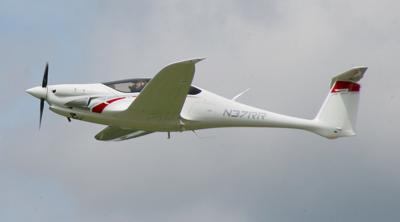
Gear retraction is fairly speedy, and produces only the slightest lateral dissymmetry as the main gear doors close, and a barely notable pitch excursion with the closure of the nose wheel (which has a modest gear door directly in front of the nosewheel). Trimmed in the climb configuration, I noted little need to retrim the aircraft after gear retraction.
At this point, I started feeling the Panthera out in terms of stability and control – the meat and potatoes of the flight test game.
Before I get into a whole lot of detail, there’s an interesting description I’ve developed from flying an ungodly number of airplanes (if you count all variations and mods, the number exceeds 1000) throughout the nearly 50 years of my career (yup, the 'magic 50' is not that far away… I soloed a glider in my 14th birthday, and my 64th year is staring me in the face… You may send condolences c/o the Aero-News home for the Aeronautically-infirm, at your discretion…).
It’s a stat that I’ve shared with a number of my friends, especially those in the test flying community and it reflects how many minutes, if at all, it takes when sampling a new aircraft, for me to have a sense of comfort -- or a lack of concern. Over the years there have been some airplanes that were comfortable right from the start… The Lockwood Air Cam and my old Glasair III (albeit for totally different reasons) comes to mind… And there are others that took their own sweet time to produce a sense of comfort, and the requisite feeling on my part that I was finally firmly in control of everything.
For instance, my first flight in the Pitts S1T took a solid 15 minutes before I felt like I really knew what I was doing (mostly due to anticipation of the upcoming landing… on a short, narrow, runway – with the obligatory direct crosswind) … And, yes, there are a few airplanes that never quite got there, including a few that I got down on the ground as soon as possible (and not necessarily on the airport we started with) because it was obvious that I had no business being airborne, and were aeronautically-speaking, a complete piece of trash.
And yes… there have been way too many of those.
The nice part about this, is that the Panthera turned out to be about a “two-minute” airplane. Meaning that I was pretty comfortable in the bird very early on, and the next hour of flight time produced absolutely nothing to cause me concern or confusion while learning the overall performance, control, and stability of the beast – even in the few areas that high-performance airplanes tend to bite.
Initial stability and control investigations revealed roll to be fairly linear and modestly responsive, but certainly no Aerobat, which is not what you may want in a traveling configuration, anyway. Rudder firms up very nicely with speed, and produces agile response for very little pedal motivation, and again picks up a wing tip quite obediently, as it couples very well with roll throughout the normal operating speed range. A proper rolling action should be preceded by rudder, which will not only aid the roll rate a bit, but will smooth out the process quite nicely producing a lovely, coordinated turn, as there is a bit of adverse yaw from naked roll inputs.
And pitch is… Sweet.
What I mean by that, is that you have a very speed stable aircraft, with a wholly linear response curve pretty much from high-speed cruise all the way down to approach configurations. Pressures are not incredibly high -- a couple pounds or so – and they firm up very nicely with speed. A conventional cooley-hat 4-way trim switch, at the top of the control stick, handles pitch obediently, and produces solid lateral trim actuations, as well. Trim is really well set-up… not too fast in overall response (especially in pitch… which WAY TOO MANY trim systems do these days), but none-the-less, a few quick blips on the hat will get you to where you want to be, no matter how out of trim you may be.
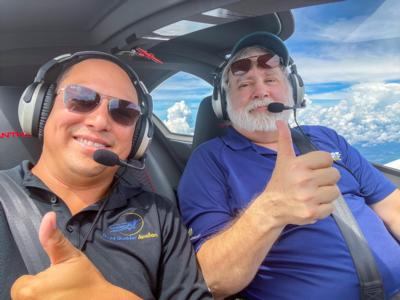
Working our way up to 6500 feet, I set up power for about 24 inches and 2400 RPM, which at that altitude and conditions were in the neighborhood of 75%. I let speed stabilize for a bit. Doing a couple of racetracks around Inverness, again at 6500 feet, gave us anywhere from 195-198 knots , consistently. Not leaning too aggressively, we were burning about 14gph while I was screwing around (having fun) and getting speed data. Pipistrel’s promise of 200 knots and 12 gph, which have drawn some eyebrows from the skeptics, appears to be close to target for conventional cruise altitudes and conditions… and an airplane that wasn’t as fresh out of the box (literally) as ours was. This baby is no slowpoke. In the cruise configuration, again, pitch stiffens up nicely, but is still very obedient with pressures picking up a couple of pounds for any serious action, rudder does likewise, and roll remains pretty consistent until you get down to approach speeds. The entire effect produces
pretty decent harmonies, (not perfect), but agile, responsive, and unwilling to upset the apple cart if you accidentally nudge a control surface a tad or look down for a fraction of a second at a chart. And again, I was feeling really comfortable with this thing fairly early on, so before I started getting into hard control investigations, I banked aggressively and did a number of high-speed climbing and descending turns, noting that I had to bring the power back on the descent side of any significant pitch down attitudes, because the clean lines of the Panthera will zoom through VNE rather quickly. No kidding.
Speedbrakes might be a good diea for future Pantheras.
We conducted more aggressive stability control investigations between 6000 and 7000 feet, and above the SCUD.
Starting with pitch, and in a 70% cruise configuration, all trimmed out, I executed a 10° pitch positive excursion, followed by full stick release. The aircraft obediently and slowly pitched down through level flight and bottomed out at 6 or 7° negative and showed a consistent 30% diminishment per cycle until pretty stable, and done with any oscillatory issues, in three. A somewhat more aggressive pitch positive excursion was started, was somewhat influenced by the fact that I had to pull back power on the downside of the first two negative excursions because the speed build up put us into VNE territory once again. We still saw about 30% diminishment per cycle. Short period, swift, pitch oscillations were induced until our inputs were about 180 degrees out of phase with the visible responses, at which point I ceased pitch excitation to note a near immediate pitch recovery and a fairly deadbeat termination to the maneuver.
Throughout all but the slower flight regimes, Static pitch characteristics, overall, are tight and very well defined, and the dynamic cycle is fairly tight, to boot. Just the way a good mini-missile should fly – and few, actually do.
Cruise speed excitation of the yaw axis with aggressive, short amplitude Rudder inputs until the input and the response were about 180° out of phase, showed yaw to be very obedient, and pretty much dead beat, the instant yaw inputs were ceased.
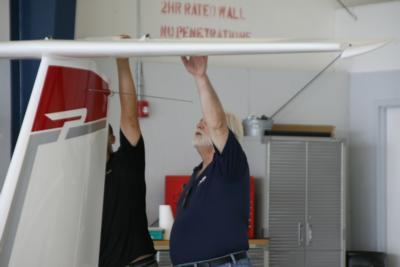
Steady heading and steady bank side slip investigations yielded fairly positive dynamic responses. Some aggressive spiral investigations showed a slight tendency to eventually overbank, which was easily corrected by a surprisingly light amount of yaw, and of course, was exacerbated somewhat in the direction of engine torque whenever power was applied.
Another item of significant note is the mechanical feel of the control system. Thanks to some beautiful engineering and design work, and the extensive use of pushrods and their undeniable rigidity and fluid reponse, versus some cabled systems, allowed the mechanical feel of the control system to be tremendously smooth. There is virtually no discernible mechanical breakaway in pitch or roll, and overt control friction is pretty much absent. Yaw is a little bit stiffer, most notably at the onset, but otherwise almost equally smooth.
Some twenty minutes into the proceedings, I noted that the cockpit remained comfortable, and that I still wasn’t rubbing shoulders or other body parts with Andy (much to his relief, no doubt) and that the cabin remained a comfortable place to do flying business. Due to some issues with the heating system (since corrected), we were getting a little heat with outside air vent input, but that became unpleasant only at lower/warmer altitudes, in slow flight, or in approach configurations.
NEXT: Part Five… Let’s slow this baby down (if we can… this thing likes speed) and see if it will bite us the way that many other high-performance aircraft tend to do. Full stalls in clean and approach configuration were done and we had the chance to see how nice a landing we could get, thanks to that delicious (and so forgiving) trailing link main gear. After that, we will finish it all up in Part Six with Final Remarks… AND, our all-important and painfully critical Flight Test Report Card. You don’t want to miss that…
 ANN's Daily Aero-Linx (04.16.24)
ANN's Daily Aero-Linx (04.16.24) Aero-News: Quote of the Day (04.16.24)
Aero-News: Quote of the Day (04.16.24) Airborne 04.10.24: SnF24!, A50 Heritage Reveal, HeliCycle!, Montaer MC-01
Airborne 04.10.24: SnF24!, A50 Heritage Reveal, HeliCycle!, Montaer MC-01 Airborne 04.12.24: SnF24!, G100UL Is Here, Holy Micro, Plane Tags
Airborne 04.12.24: SnF24!, G100UL Is Here, Holy Micro, Plane Tags Airborne-Flight Training 04.17.24: Feds Need Controllers, Spirit Delay, Redbird
Airborne-Flight Training 04.17.24: Feds Need Controllers, Spirit Delay, Redbird








